Ad Details
-
Ad ID: 2295
-
Added: January 30, 2021
-
Location: United States
-
State: Arizona
-
City: Yuma
-
Views: 420
Description
Babaji Yoga Sangam Establishes Unique Temple in Arizona
Tamil Siddhantam Yoga Center Founded on Rameshwaram Theme in Southwest U.S. Desert
Arizona – classic symbol of America’s Old West, rich in legends of the Indian leaders Geronimo and Cochise, dotted with rugged towns like Tombstone, where was fought the battle of the OK Corral. Arizona – a land where the traveler is struck instantly with the awesome beauty of the arid, desert countryside somehow surviving the Death Valley sun, of cactus reaching skyward in shadows of craggy out- croppings of extraordinarily colored rock formations, of nature in her harshest visage, of rattlesnakes and groundhogs, scorpions and sand, oceans of white, hot, ominious sand, of brilliant skys and never-before-seen flora. Just down the road the desolation ends and one enters the modern, sophisticated, fast-growing Arizona cities: Phoenix, Yuma, Tuscon and Flagstaff. Here, the traveler finds every amenity of the modern world and soon forgets he is in the midst of a grand wilderness.
Now at the edge of the town of Yuma city on the Colorado River (famous for the Grand Canyon) near the border of California and less than 100 miles north of Mexico, a new structure has appeared, oddly different from both the natural landscape and the man-made features of Western civilization. Here, Asian Indian Guru, Yogi S.A.A. Ramaiah of the Tamil Saivite tradition has erected America’s newest Siva temple, the Babaji Ramalingeshwarar Kovil, nestled among dormitories and an ashram complex of one of the main centers of the Babaji Kriya Yoga Sangam.
The temple, cubical in shape with a tiered pyramidal vimana on its roof is an enchantingly colorful edifice, visible along Highway Eight for many miles. Each of the seven tiers of the vimana represents one of the chakras, or mystical force centers, in the nervous system of man which govern consciousness at its manifold levels, and range in color from red, for the muladhara, to violet, for the sahaswara chakra at the very top. At the pinnacle towers a large trident, one of the important symbols of Saivism. In front of the trident is a large Tamil “Aum.” And to make the temple even more visible for low flying aircraft, the word Yoga is displayed in three-foot high neon lights.
Yogi Ramaiah founder of this international yoga organization with 52 centers worldwide, was born in Tamil Nadu. He first came to the U.S. in 1968 and is now an American citizen. He personally presided at the consecration ceremonies of this new temple, on Thursday, March 31st, the culmination of which occurred between the hours of 10:30 p.m. and 12:00 midnight.
Mystical roots: An unusual structure for Arizona, yes, but in its philosophic and mystical underpinings one may find much in common with the American Indian heritage of this area. Though in most cases these days, the American Indian tribes, living on reservations, have been converted, often enmasse, to Christianity, their root religion was a pragmatic and mystical one. As Manly P. Hall writes: “The North American Indian is by nature a symbolist, a mystic, and a philospher.” The American Indian lived in close rapport with the forces of nature and the cosmic agencies. They believed strongly in guardian spirits and gods, and, many tribes, had knowledge of reincarnation. Most of all, they were mystics, and tales of the miracles and magic worked by medicine men of tribes across the continent abound in literature by early French missionary explorers. According to the concepts of the Babaji Kriya Yoga Sangam, the American Indian people actually migrated many centuries ago from Tamil Nadu, South India.
Perhaps it is only natural that an Asian Indian temple has found a place on this ancient American Indian soil. Perhaps it is to be expected that a temple of Saiva Siddhanta, firmly based in the mystical laws of yoga and invocation of the Gods, should spring up in this land where inner worlds are imbued with the red man’s heritage. The Yoga Sangam has established at least two sites of worship on sacred Indian ground: one, an Ayyappa Swami Yantra shrine high in the frozen stillness of Mount Shasta, and the Thiruvannamalai Sadhana Caves in the Imperial Valley desert – both in California.
Inner Orders: According to a disciple, Yogi Ramaiah is in telepathaic communication with his master, Kriya Babaji Nagaraj, 24 hours a day. A little over a year ago, Yogi Ramaiah received instructions from Babaji to build a temple in Yuma City. These inner directions included details of the design and placement of deities.
S. Swaminathan of the Santa Cruz Kriya Yoga center explained that Babaji Kriya Nagaraj was initiated centuries ago by the renowned Saga Agastya into the Tamil Yoga Siddhanta and the secrets of kundalini and pranayama. In the course of his sadhana Babaji is said to have attained Swarupa Samadhi which endowed him with the ability to live in his physical body indefinitely. The Kriya Yoga centers teach that he has remained in his physical body all through the centuries, helping to guide mankind, and that he has founded as his “epicenter” the Gauri Shankar Peetham, or ashram, near Badarnath in the foothills of the Himalayas in northern Indian.
Upon receiving his directions form the his Master, yogi Ramaiah immediately sent a message to Tamil Nadu to order the deities for the temple to be carved in stone. Two famous Tamilian craftsmen, called stapathis, had a hand in the work – Ganapathi Stapathi, head of the famed Mahabalipuram School of Sculpture, and Subramuniya Stapathi, now connected with the Tirupati temple in Andhra Pradesh.
The unusual temple, which contains elements of the Vaishnava and Saivite traditions, is meant to replicate the theme of Rameshwaran in India, where Rama worshipped Lord Siva after returning from Sri Lanka where he was victorious over Ravana. On the main altar, in the center of the room, is a carved dolomite limestone Siva Lingam acquired in Banaras, India and consecrated at the famed Kasi Visvanatha temple before it was brought to America. Surrounding the central Lingam are murthis of Rama, Sita Lakshmana, Hanuman and Kriya Babaji Nagaraj.
Fifty yards from the temple in a grove of trees, where Navaho or Hopi Indians may have once performed their mystical rites under the Arizona sky, mantra yajnas are now performed at the time of Kriya Yoga Siddhantam initiation and special sadhana. Walking on the platform in front of the temple entrance, there is the traditional Nandi the bull and a balipeedam. To the left there is a beautiful dancing Ganapathi, to the right a Guru shrine. As you enter, to the left of the door is the Saivite tilak of the Tripundra to the right is the Vaishnava tilak of the Namam. Above the door itself are the Saiva symbols of the Lingam, Nandi and the Trisula and the Vaishnavite symbol of Shree Chakram, symbolic for the tolerance at this temple between these two sects. Inside the temple surrounding the central peedam are granite idols of the 18 Tamil Yoga Siddhars, which include Boganathar, Patanjali, and Tirumular, all “witnessing” Rama perform puja to the Siva Lingam. On the walls are brilliant murals depicting Puranic stories.
Prior to kumbabhishekam ceremonies, 48 days of sadhana were performed by the devotees. All the murthis had been consecrated with the Ayurvedic oil preparations required before abhishekam, and water was brought from several rivers, including the Ganges and Kauvery in India, Manick in Sri Lanka, and the nearby Colorado River. These waters were all consecrated according to shastric injunction. On March 31st, a Yajna Peedam was established and homa was performed continuously for six hours using the Siva Beeja Mantra. Finally, at the most auspicious hour for Siva – midnight – abhishekam was performed to all the murthis with yogi Ramiah himself and one of his disciples pouring the sacred waters over the trident at the top of the vimana. A small piece of heaven has been brought to earth, another place of pilgrimage for Hindus in America.
Yogi Ramaiah explained that the Babaji Ramalingeshwarar Kovil will perform arati and offerings of sacred grass and flowers daily. All rituals are done in the Tamil language. Abhishekam will be performed once a month or when a special occasion warrants. The temple is open to members of all religions. Two major festivals will be observed at this temple, Maha Sivaratri and Ramnavami.
Mission of Harmony: Yogi Ramaiah related to a NSW interviewer that he was trained by Kriya Babaji Nagaraj in India in the Himalayas. In 1954, commissioned by his master, he undertook the mission of spreading the scientific art of Tamil Yoga Siddhantam all over the world and promoting religious and racial harmony by teaching humanity to find peace inside themselves first through the practice of Kriya Yoga as handed down from Kriya Babaji Nagaraj and the eighteen Tamil Siddhars. Yogi Ramiah explains that “Everyone has the right to love their own religion, but no one has the right to hate any religion.” He tells people that if they are Saivite, to practice their Saivism, and not just profess to be Saivite. He teaches that one cannot attain salvation unless he first shows the path to others.
Yogi Ramaiah is firmly dedicated to religious harmony for the vitality of Hinduism. He discloses, “For example, this is a Saivite temple, where even Vaishnavas can come and worship, so that really makes the people closer, rather than saying ‘Mine is the only path…’people can come here and understand the importance of Saiva Siddhantam, and that is a graceful way of doing it. As a matter of fact, even non- Hindus are coming to have a look at this religious system and see what it is all about.”
Spiritual Life: The Yoga Sangam teaches its members to follow the Tamil culture, which includes being an asset to the community in which they live and to work in the world as contributing members of society. Students are taught to remain celibate before marriage and then, as older married people, to live the life of the vanaprasthi, devoted to spiritual life. Yogi Ramaiah says, “There are very few sannyasins in the International Babaji Kriya Yoga Sangam because the rules of the order are extremely strict: sannyasins cannot stay in one place for more than three days; they must beg for their food and may not even touch money.” And those few sannyasins are all in India. Yogi Ramaiah explained that there are hundreds of thousands of people coming to learn about the yoga postures and basic teachings of the Babaji Kriya Yoga Sangam. Of those, only a few thousand actually take up the consistent practice of the teachings, and of those thousands, 1,321 people to date have been diligent and committed enough to receive initiation, which allows them to teach and serve as leaders. The training of these “few” consists of their being taught the deeper practices of kundalini yoga, pranayama and bija mantra japa. There are several levels of initiation, and all given by Yogi Ramaiah himself, though he said the first initiation can be given by advanced teachers he authorizes.
For one of the more advanced initiations, the devotee comes to one of the Sangam’s centers to live for a period of three days of intensive sadhana. During the last day there is a period of bija mantra japa that lasts for 24 hours and initiation by the homa fire. Those who receive this training are the ones expected to carry the work forward and outreach to the world.
The Kriya Yoga Centers, of which there are 16 in the U.S., Yogi Ramaiah explained, are structured according to the needs and nature of the members and the requirements of the area. Some are only for the ladies, who may reside there fulltime; others are for men, and in some, married couples may live. The activities revolve intensely around the performance of the yoga sadhana, which then creates a spiritual environment. The dynamic yogi explained that though they may not have huge structures, the spiritual vibrations of the centers will benefit the people who come for generations into the future.
In the U.S., interest and participation in the teachings of the Sangam has come mostly from young, born Americans. There was, Yogiji points out, a very good turn out of Asian Hindus at the Yuma temple consecration considering their total number in the area. In the country of Malaysia, on the other hand, the participants are mostly Asian Hindus.
Open Arms: Like his new temple, Yogi Ramaiah’s yoga teachings are open to people of all religions: “If we teach yoga to the Christians and Moslems, then they will find inner truth and inner peace. This, in itself, will lead them to abdicate their fanatical conversion efforts and seek more to live in harmony with other religions.” He also noted that by teaching our Hindu brothers and sisters to be economically useful and self-sufficient, we reduce the likelihood of conversion to other faiths.
For more information on this new and beautiful temple, call (602) 783-7239: or write to Babaji Ramalingeshwarar Kovil, 5750 West 8th Street, Yuma City, Arizona 85364.



























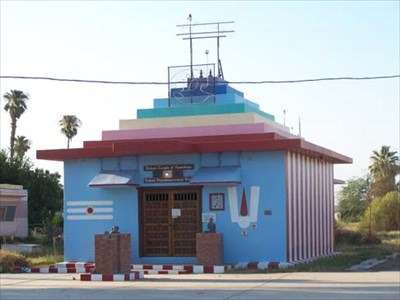

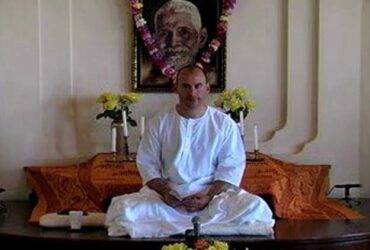
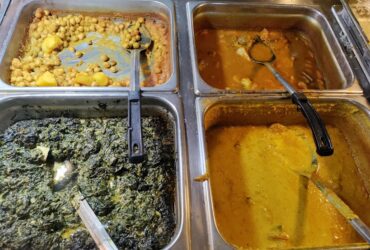

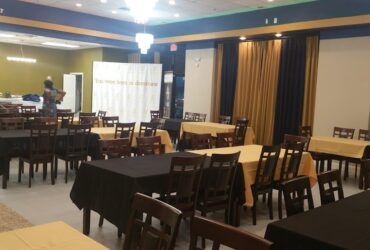
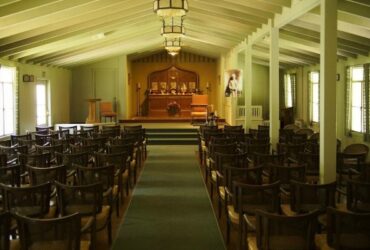
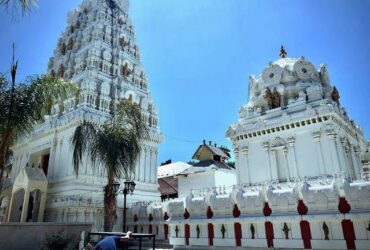
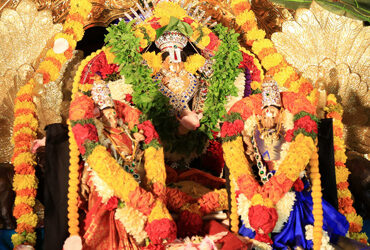






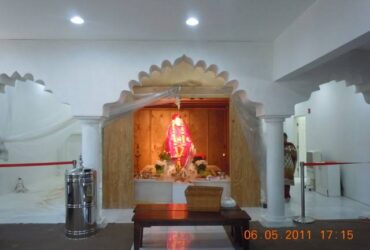

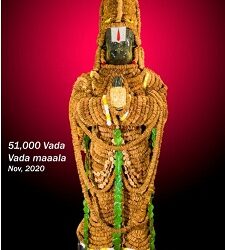

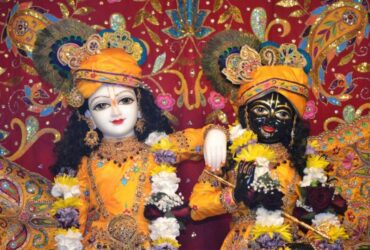

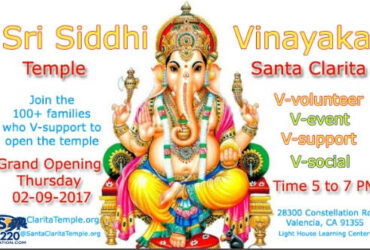









Leave a Comment
Your email address will not be published. Required fields are marked. *